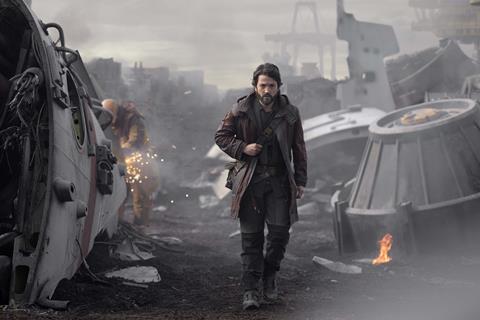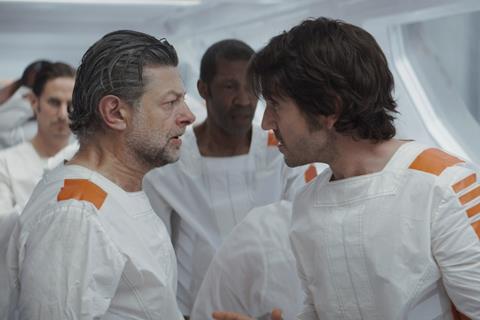
At the end of 2016’s Star Wars prequel Rogue One: A Star Wars Story, Diego Luna’s rebel spy Cassian Andor paid the ultimate price for stealing the plans to the Empire’s dreaded weapon, the Death Star — a story that led directly into George Lucas’s original film. Rogue One was a hit with both critics and fans, who praised its gritty, realistic take on the fantastical universe. But given his character’s spectacular demise, it looked to have been Luna’s first and last shot at Star Wars glory.
The following year, however, Lucasfilm president Kathleen Kennedy called Luna with a proposal. How would he feel about reprising his role as Cassian in a Star Wars TV series that took place in the years leading up to Rogue One? “It was a very vague commitment,” recalls the Mexico-born actor of what, six years later, would lead to Disney+ streaming show Andor. “It was something like, ‘Are you willing to consider the possibility of doing something, maybe, if it turns out great in this new format that we are about to start exploring?’ Because, back then, there was no Star Wars TV series.”
Luna, who shot to fame in Alfonso Cuaron’s 2001 feature Y Tu Mama Tambien, was intrigued. Moreover, he felt there was fertile ground left to explore. “Rogue One is about an event. Therefore, there was room to talk about the character and answer everything the film doesn’t, to understand the background of someone like [Cassian] being given this very important mission. These are regular people until they are willing to do what no-one else will, which is sacrifice everything. What needs to happen for you to get there? What makes Cassian a great character to develop a series [around] is he’s just a regular guy.”
With Luna on board as star and executive producer, Lucasfilm began developing ideas with various writers but nothing stuck. “Time passed, there were a few attempts to find a way and we were not finding it,” he recalls. “Many ideas didn’t last, because we were all the time thinking, either we do justice to this character and to the love for Rogue One, or we do nothing.”
Eventually, Kennedy turned to Michael Clayton writer/director Tony Gilroy who had been drafted in to help during production on Rogue One. What Gilroy proposed was a five-year-long story that would end where Rogue One began. But he would only commit if Luna was on board. “Tony said, ‘I’m not going to go write anything unless you’re on my side.’ He pitched me the whole arc. I went, ‘Wow, I’m with you.’”

The result was the first season of Andor, its 12-episode run standing apart from other Star Wars shows — not just because it was shot on real sets and locations rather than the mostly digital environments of the Volume, but because it was a gritty spy thriller aimed at adults rather than kids, less about the Force and fan service and more about bureaucratic ambition and the seeds of revolution. “The show wants to tell a story that hasn’t been told in the universe of Star Wars, about those who are not ever in the centre of the story,” says Luna. “It’s about what happens in the darkest moments in this galaxy where there are no Jedis, no mysticism, where apparently everything is lost. That’s when the people matter. That’s how a revolution starts. The idea was to talk about oppression, but not from the perspective of the elite. This is about how oppression feels when you’re on the bottom.”
In the opening episode, we meet a very different Cassian to Rogue One. A thief and smuggler, he begins by visiting a brothel looking for his lost sister, then shoots a man in cold blood and finds himself on the run, eventually joining forces with Stellan Skarsgard’s mysterious Luthen Rael who unlocks his rebellious side. But it is only after Cassian is thrown into an imperial prison that his leadership qualities come to the fore.
“At the beginning, there’s no difference between Cassian, [Kyle Soller’s ambitious security guard] Syril or anyone in this show,” he says. “And that’s what makes the writing — and the acting, obviously — very interesting because it’s full of ambiguity and constant contradiction. That makes Cassian very exciting to play and interesting to watch, because you don’t expect characters that are there from beginning to end to be that contradictory. That’s when this story feels realistic and invites audiences to get into the skin of the characters.”
For that and so much more, Luna has nothing but praise for Gilroy. “Tony’s unique. I really like his writing, but I also like his perspective. I like that he’s specific, that he’s stubborn, that he commits to an idea and takes it to the end. He has his own process and is behind every decision. He gets his hands dirty. He goes deep.”
Although Gilroy is across every aspect of Andor, as a showrunner, says Luna, he was “barely is on set. He likes giving directors the freedom, so sometimes my position becomes interesting because you become a bridge. I’m here, first as an actor, second as an actor that’s going to be around from beginning to end. Naturally, you become a producer.
“In a show like this, where everything is happening at the same time, sometimes there’s the need for someone on set making sure things move forward, not just from an actor’s perspective,” he continues. “Directors come and go, I don’t. I’m there to help Tony, to help Sanne [Wohlenberg] — she is the producer who runs the show on the ground — to help the team.”
The result has been some of the best television of the year — nuanced, compelling and relatable — with episodes eight (‘Narkina 5’), nine (‘Nobody’s Listening!’) and ten (‘One Way Out’) the highlights of a standout first season. Directed by Toby Haynes, this three-episode arc saw Cassian incarcerated in a floating prison with electric floors, where its barefoot inmates build machinery for the Empire — machinery that is revealed to be part of the Death Star that will ultimately kill him. While locked up, Cassian discovers he is a born leader, transforming fellow prisoner Kino Loy (Andy Serkis) from a by-the-book foreman into the instigator of a rebellion against their imperial captors. “[Cassian] is part of the awakening of this man, and it’s a metaphor for his own,” says Luna. “It’s a very strong piece of writing. And that brings great actors. I had no idea how important Kino Loy was in the life of Cassian until I met Andy Serkis’s Kino Loy.”
Staying on track
Gilroy originally pitched Andor as five seasons long. But after it took two-and-a-half years to make the first, he and Luna opted to wrap everything up in just two, with the final 12 episodes telling four years’ worth of story. “The shoot takes almost eight months,” says Luna of the reasons for the change. “We are shooting on locations, it’s very complex [and there are] so many speaking parts. And 12 episodes — we’re basically doing four films. It’s impossible to think of this show being done faster.”
At time of writing, there were about 10 weeks of filming left on season two — although the production has had to make do without Gilroy since May 2 when the Writers Guild of America went on strike. Fortunately all 12 scripts were completed before Gilroy was obliged to walk away. “I hope this gets solved soon and we get him back because I miss him dramatically,” says Luna, speaking to Screen International after a day on set. “But the good thing is it’s the same people [making the show] as before. We know what we’re doing. And we have a system and a head, Sanne, that keeps this train moving.”

























No comments yet